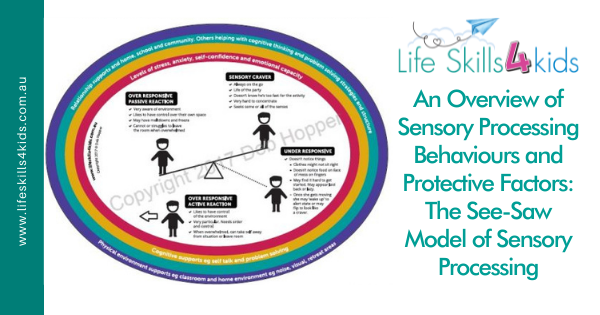Whether we are seeing children in our classroom or clinic, there are many sensory processing behaviours, clues and responses that we need to filter as we try to work out:
- Why are they showing this behaviour?
- Are they tired?
- Are they missing a parent who’s away for work this week?
- Are there any triggers?
- Is it too loud, or too visually busy?
- How can we support and encourage them to recover from this behaviour?
- Can we remove some triggers? Can we modify the environment?
- Do they understand the expectations of the task?
- Are they feeling overwhelmed?
- Do they understand that their behaviour has changed?
- Are they aware that they are frustrated, upset, or in meltdown, or has their nervous (limbic) system taken over making them unable to think rationally?
I developed the See-Saw Model of Sensory Processing earlier this year to show, graphically, the different types of behaviour that we often see in children at school, in our clinics or in their homes. It is based on the theory of Winnie Dunn’s model of sensory processing, which discusses children who may show different responses to sensory information.
The sensory craver is a child who has a high neurological threshold and actively seeks out sensory information. They are often on the go, moving fast, perhaps act impulsively, find it hard to concentrate, and seek out different senses.
The under-responsive child
The under-responsive child also has a high threshold, but they self-regulate passively. This child might not notice things. He might not notice that his clothes are twisted on his body, or that he has food on his face. He might not notice that his friends have moved while he’s eating lunch, and might get left behind. She may find it hard to start tasks, or get going. She might be labelled ‘lazy’.
The over-responsive child
The over-responsive child has a low neurological threshold. This means that a little bit of sensory information can feel ‘way too much’. He notices every grain of sand on the floor. She is overwhelmed by the radio on in the car, or holds her hands over her ears when the toilet flushes.
The over responsive child can respond in one of two ways.
- If he is able to be active in his response, he might run away when the video is on in class. This might be seen as being ‘wrong or inappropriate’, but from a neurological perspective, he is in the ‘flight’ phase of a stress response, and is running away because he is overwhelmed.
- On the other hand, a child who shows a passive response when faced with too much sensory information will move into the ‘freeze’ phase of a stress response. They freeze and can’t move when it all seems to much. This often looks like the child who crawls under the desk when overwhelmed, or sits at the desk, but is in shutdown and cannot answer you back.
In this graphic model, the circles around the outside show the different factors that can impact on sensory processing.
This includes:
- Levels of stress and anxiety, self-confidence and emotional capacity
- Cognitive supports e.g. self-talk and problem solving
- Relationship supports at home, school and community
- Physical environment support in the classroom and the home environment e.g. noise, visual inputs and sensory safe retreat areas.
In our blogs over the next few months, we will be looking at the circles that surround this model and how we can support children with sensory processing disorders.
RESOURCES FOR PARENTS & PROFESSIONALS
Download your high res PDF image of The See-Saw Model of Sensory Processing.
If you have specific concerns about your adolescent child, download this practical tip sheet for Self Regulation in Teenagers.

